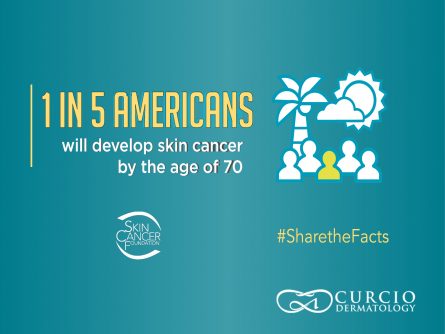What is skin cancer?
Most simply put, cancer occurs when your cells grow at an abnormal rate. This abnormality is caused by changes to your DNA, called mutations, which may be caused by outside factors, may be genetic, or may be a combination of both genetics and external factors. In skin cancer, the external factor that usually contributes to these mutations in the DNA is Ultraviolet (UV) radiation, which is found in sunlight and tanning booths.
Since skin is the largest organ on your body, and it is constantly exposed to the elements, it comes as no surprise that it is one of the most common cancers that people can develop. With that in mind, it is important to understand skin cancer and be aware of any potential skin cancer developments.
Who is at risk of getting skin cancer?
Even with the proper measures taken, it is possible to develop skin cancer on skin that has not been exposed to the elements. However, increased skin cancer risk factors include the following:
- Having fair skin, especially those with blonde hair and blue eyes
- Working outdoors for extended periods of time
- Family history of skin cancer
- Having moles
- History of sun burns
- Weakened immune system
- Exposure to radiation
- Certain medications or skin treatments that may make you photosensitive
- Tanning
- Exposure to toxic substances
Signs and Symptoms of Skin Cancer
Skin cancer usually presents itself in the form of a new mole or other growth on your skin. Depending on the type of skin cancer, these moles may have different appearances and may show up on different parts of the body. These moles may also show up in areas that are not commonly exposed to the sun, so it is important to monitor every surface of your body, including between your fingers and toes and on the soles of your feet.
Below, we have listed some common signs of a cancerous mole. It is important to see your doctor / dermatologist immediately if you have any doubts / concerns about your skin. Your doctor will be able to determine if further testing, such as a biopsy, is needed.
- Changes in the shape, size, or color of an already existing mole
- Moles or lesions that bleed
- Scaly or crusty lesions
- Large brown spots, sometimes with smaller spots inside
- Lumps on the skin
- Any painful or itching lesions
- Moles or lesions with irregular shapes and borders
- Lesions that appear to be a rash but continue to develop over time
Skin Cancer Prevention and Detection in Nashville
The following tips can help you to prevent skin cancer or at least detect it early. We recommend that everyone follow these tips, regardless of skin tone. If you live in an area, such as Nashville, TN, where exposure to the strong southern sun is common, it is even more important that these tips are followed due to the increased risk.
- Regularly check your skin for any changes and immediately seek the advice of your doctor if you become suspicious of an area. It is advised to do a thorough check of your skin about once per month. We recommend following these instructions on how to properly check your skin for signs of cancer.
- Avoid direct exposure to the sun. This tip is especially important when the sun is highest in the sky.
- When in the sun, cover as much skin as possible through long sleeves and hats whenever possible.
- Wear sunglasses that protect you from UV rays.
- Use sunscreen on any exposed skin year-round. Even when it is cold or cloudy out, you will still be exposed to UV radiation from the sun.
- Avoid tanning booths and tanning beds.
- Take extra precaution to avoid the sun if you are on medication that makes your skin photosensitive. Check with your doctor if you are unsure about the side effects of any medication you are on.
In order for sunscreen to be effective, it is important to follow label instructions and use sunscreen properly.
Seeing your Nashville Dermatologist | Curcio Dermatology
If you have a mark or bump on your body that you have discovered in a self-check, you may be inclined to get it looked at by a medical professional. A skin cancer screening will be conducted on your body by a professional to look for moles, birthmarks, or other marks that are unusual in color, size, shape, or texture. The screening itself will not diagnose you with skin cancer, but it may be determined that a biopsy is necessary. If a biopsy occurs, a sample will be sent to a laboratory where a definitive diagnosis can be made. Going through this process is important due to the fact that early detection and early treatment can help prevent more serious symptoms from progressing.
When you go in for a skin cancer screening, it’s good to know what to expect. At Curcio Dermatology, you will be asked to disrobe and put on a disposable paper examination gown so that the dermatologist may check your body from head to toe for any unusual markings.
The dermatologist conducting the screening may use tools to see spots better, such as a magnifying glass. It is recommended that you wear your hair loose and do not wear makeup so that the examiner can see your skin and scalp clearly. The exam may take from 10-15 minutes and if the dermatologist sees something of note, you may be called in for another test or in some cases an immediate biopsy.
Patient comfort and respect is a priority during this process, and Curcio Dermatology recognizes that feelings of embarrassment may occur and are normal. It is important to remember that your dermatologist is a highly trained professional and that this screening is important for your health and safety. At Curcio Dermatology, you will be treated with the utmost respect and dignity during this process. To schedule a skin cancer screening at our Nashville office, please call (615) 679-9011 or complete the online appointment request form at https://www.curciodermatology.com/schedule-an-appointment/.







